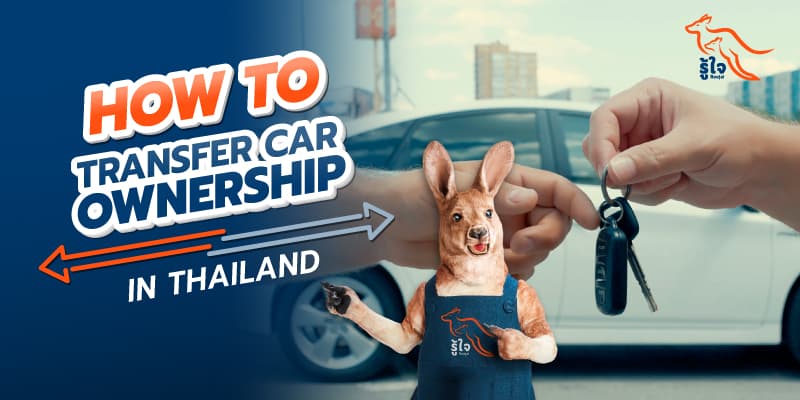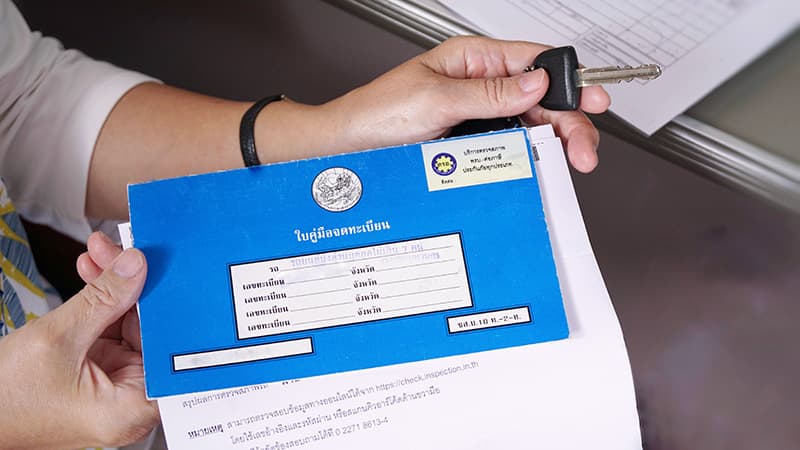
Transferring car ownership in Thailand can seem daunting at first, but with the right information and documents, the process is quite manageable. Whether you’re an individual, a company, or dealing with an inheritance, ensuring the new owner is legally recognised is crucial. For foreigners, this process is often simpler than you may think.
We have compiled some helpful information to guide you through each step. Let’s dive in and make your car ownership transfer as smooth as possible!
What is a vehicle transfer or change of ownership?
A vehicle transfer involves changing the registered owner of a car. This can occur when buying or selling a second-hand car, passing it on to a family member, or similar situations. Transferring car ownership is important, particularly in legal contexts. For instance, if a car is sold or given to a new owner but not officially transferred, the original owner remains liable. In the event of an accident, if the new owner is at fault, or if the car is used illegally, the original owner will be held responsible.
Therefore, whether you are buying, selling, or passing on a car to someone else, it is crucial to transfer the car to the new owner’s name as soon as the details are finalised. This helps prevent any potential issues that may arise in the future.
Types of car ownership transfers
There are two methods for transferring car ownership in Thailand: direct transfer and floating transfer, each with its own distinct procedures.
1. Change of car ownership by direct transfer
Change of ownership by direct transfer is straightforward. The current and new owners need to visit the Department of Land Transport (DLT) office to request the transfer. The request needs to be submitted at the same DLT branch the vehicle was originally registered at. Ensure that the vehicle details matches the information featured in the car registration book. If the information is incorrect, it must be updated to reflect the actual details before proceeding.
2. Change of car ownership by floating transfer
Transferring the ownership of a car through floating transfer involves the original owner (seller) providing the necessary documents to the new owner (buyer) to complete the transfer independently after the sale. The seller must fully sign all the required documents. This method is particularly popular among used car dealerships because it saves the seller time during the transfer process.
But there are two sides to the coin when it comes to floating transfers due to the risks it entails. In the case that the car is involved in illegal activities while the transfer has not been completed, the original owner will be legally liable.
Required documents to transfer a car ownership in Thailand
Now that you’re familiar with the two main types of car ownership transfer, here’s what you will need to successfully transfer a car ownership, both as a local and as a foreigner in Thailand:
- The vehicle, which must be taken to the DLT office for an inspection.
- The car registration book, also known as the blue book in Thailand.
- Required forms:
- Ownership transfer form signed by both the seller and buyer.
- Power of attorney form for any party not present at the DLT Office.
- Vehicle sale contracts, receipts and invoices.
- Signed copies of personal documents from both the seller and buyer.
For Thais:
- ID card and a copy of the front and back on one page.
- House registration book (Tabien Baan)
- Additional documents (if applicable): Name change documents, divorce papers, death certificates, will, etc.
For foreigners:
- Original passport, along with copies of the info page and current visa stamp.
- One of the following:
- Certificate or letter of residence issued by Thai immigration. A TM-30 and a visa with a minimum of 30 days remaining are required for this letter.
- House title (yellow book) with your name. The original is needed on the day of transfer.
- Work permit, only if it lists your home address in addition to your work address. Note that if you have a digital work permit, ensure you submit a printed copy that has been stamped and certified by the Department of Labour.

Steps for car ownership transfer
The process of transferring vehicle ownership in Thailand is quick and straightforward if you follow the procedure carefully. You can complete it at the following locations:
- Bangkok Land Transport Office: For vehicles registered or located in Bangkok.
- Provincial Transport Office: For vehicles and owners located outside Bangkok.
- Specified Provincial Transport Office: As listed in the vehicle registration manual or where you have requested to use the vehicle.
Procedure:
- Visit a DLT office and bring the vehicle you wish to transfer.
- Have the vehicle inspected at the designated inspection station or building.
- Purchase the compulsory car insurance (Por Ror Bor) for the new vehicle owner from an insurance provider available at the DLT office or another location.
- Submit an application and contact an officer to help you with the submission. Attach the necessary supporting documents and pay the required fee.
- Once the process is complete, wait to receive the updated car registration, along with the receipt, tax payment mark, and vehicle licence plate.
How long does the process of a car ownership transfer take?
The process of transferring car ownership in Thailand involves several steps and can vary in duration depending on various factors. Generally, the vehicle registration document will be ready within 15 working days after the application is completed.
When sending the car to the DLT office for an inspection, plan to be without the vehicle for the entire day as the paperwork can take 1-2 business days to process. If the car is being transferred out of the province of registration, the registration must be updated first, which takes 3 business days.
It is crucial to notify the DLT office within 15 days of the vehicle transfer to avoid a fine of up to THB 2,000, ensuring that the transfer is officially recorded and that you are complying with Thai law.
Vehicle ownership transfer fees
The fees for transferring vehicle ownership are consistent across all local transport offices. The breakdown is as follows:
- Ownership transfer request fee: THB 5
- Vehicle transfer fee: THB 100
- Registration book replacement fee: THB 100 (if the registration book is damaged)
- Licence plate change fee: THB 200 (if a new licence plate is needed)
- Stamp duty: THB 500 per THB 100,000 of car valuation
Common mistakes to avoid when transferring car ownership in Thailand
Transferring car ownership can be a smooth process if you avoid some common pitfalls. Common mistakes to watch out for are:
- Incomplete documentation: Ensure you have all the necessary documents, including the original car registration, proof of identity, and a signed transfer form. Missing any of these can delay the process significantly.
- Not notifying the insurance company: Not transferring, updating, or canceling the previous car insurance can cause complications. Make sure to notify the insurance provider about the change in ownership to avoid coverage issues.
- Overlooking the vehicle inspection: Some transfers require a car inspection. Skipping this step can cause delays or even rejection of your transfer application. Check if your vehicle needs an inspection and schedule it accordingly.
- Not paying outstanding fines or taxes: Ensure all fines and taxes related to the vehicle are paid before initiating the transfer. Unpaid dues can halt the process until they are cleared.
- Not verifying the seller’s identity: Always verify the identity of the seller to ensure they are the legitimate owner of the vehicle. This can prevent potential fraud or legal issues.
- Not keeping copies of documents: It’s important to retain copies of all documents submitted during the transfer process. These copies can be invaluable for future reference or if any issues arise.
Key takeaways for car ownership transfer in Thailand
This detailed guide covers all the steps and information needed for switching ownership of a car. It’s a valuable resource for anyone considering buying, selling, or passing on a vehicle. Don’t forget to transfer or cancel the car insurance policy, depending on the terms and conditions of the policy and the insurance company. Roojai offers car insurance that can save you up to 30% on premiums. With a network of over 1,600+ garages and repair centres throughout Thailand, you can tailor your coverage to fit your lifestyle perfectly.
Stay updated with the latest news and information on health, cars, motorcycles, and various online insurance options by following Roojai on our Facebook page. You can also add us as a friend on LINE (Official LINE ID: @roojai).


